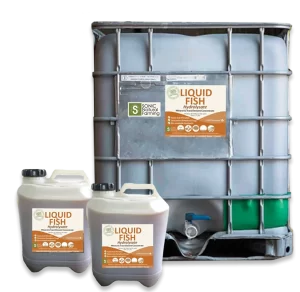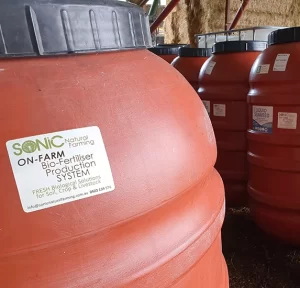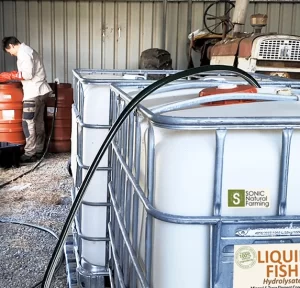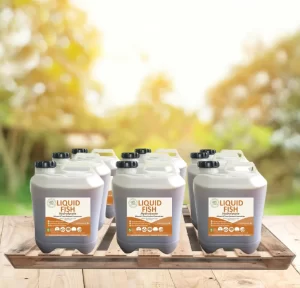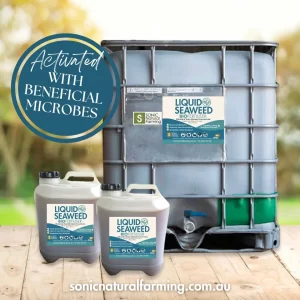Unlock the full potential of your soil by incorporating biologically activated Liquid Fish Hydrolysate Fertiliser into your management practices—transforming your farm with enhanced soil biology and organic nutrition for healthier, more nutrient-dense crops.

Mineral Concentrate with Beneficial Microbes
- Microbial Stimulant: Increases fungal biomass and feeds beneficial microorganisms.
- Organic Minerals: Delivers organic nitrogen, amino acids and trace elements.
- Soil Builder: Boosts organic matter levels, creating well-aerated soil for healthy root growth.
- Disease Resistance: Promotes soil microbes that strengthen crops against environmental stresses including drought, salty soil and frost.
*Low Odour Formula
Beneficial for Seeds, Seedlings, Potted Plants, Vegetables, Orchards and Cropping
Fast Quotes, No Hassle
SONIC Liquid Fish Mineral Concentrate - TYPICAL ANALYSIS
| Nutrient | Amount (mg/L) |
|---|---|
| Nitrogen (N) | 3500 |
| Phosphorus (P) | 1600 |
| Potassium (K) | 5100 |
| Sulphur (S) | 900 |
| Calcium (Ca) | 3900 |
| Magnesium (Mg) | 700 |
| Sodium (Na) | 500 |
| Iron (Fe) | 50 |
| Manganese (Mn) | 5.1 |
| Zinc (Zn) | 2.9 |
| Copper (Cu) | 2.5 |
| Cobalt (Co) | 1 |
| Boron (B) | 5 |
| Molybdenum (Mo) | 1 |
| Selenium (Se) | 0.05 |
| Microbes | Amount (cfu/ml) |
| Lactic Acid Bacteria | 6000000 |
| Fungi | 2000 |
| Yeasts | 120000 |
| Actinomycetes | 1000 |
| Photosynthetic Bacteria | 1000 |
Curious about the benefits SONIC Liquid Fish could have on your crops?
Product Price Guide
Choose your Supply Option
ON-FARM DIY PRODUCTION SYSTEM

Starting from 360 Litres combined products
SONIC DIY Biofertiliser Production System includes assisted setup and 1:1 hands-on training with our expert trainers.
✔ Eliminate major freight costs
✔ Reduce packaging costs and waste
✔ Access quality raw ingredients
✔ Lifetime support and troubleshooting
✔ Proven results for Aussie farmers
$1.00 – 1.50/L
ON-FARM PRODUCTION SERVICE

Starting from 2,160 Litres/yr combined products
SONIC On-Farm Production Service provides experienced operators to produce fresh products in regular batches, directly on your farm.
✔ Eliminate major freight costs
✔ Reduce packaging costs and waste
✔ Access 100% Australian raw ingredients
✔ Guaranteed quality outcomes
✔ Proven results for Aussie farmers
Starting at $1.95/L
MADE-TO-ORDER PRODUCTS

Starting from 180 Litres per product
SONIC Made-to-Order Products are processed and supplied fresh for optimal results.
✔ Available in 20L and 1,000L containers
✔ Fast, reliable delivery Australia-wide
✔ 100% natural Australian ingredients
✔ Proudly Australian-made
*Allow up to 8-10 weeks for processing. Contact us for price and availability.
$2.35 – 3.90/L
Note: All prices are in AUD and are indicative only. GST and shipping costs are not included. The listed prices for the SONIC DIY System apply after the completion of training. Additional fees may apply. Click here to get a customised quote within 24 business hours.
Product Range
Talk to Us About Cost-Saving Supply Options for your Farm.
Regenerative Farming Solutions – Latest Articles
4 Good Reasons To Feed Soil Microbes All Year Round
Soil microbes play a critical role in crop performance, nutrient cycling, and soil health — but they don’t just work when the weather’s perfect....
Seaweed Biofertiliser Uses In Regenerative Farming Systems, Australia
Discover how Australian regenerative farmers are using seaweed biofertiliser as a seed inoculant, foliar spray, and soil drench to feed soil microbes, boost crop resilience, and build healthier, more productive systems—naturally.
Soil Microbes: Nature’s Solution to Cutting Costs on Aussie Farms
If you're looking to reduce costs on the farm and boost your soil health at the same time, then focusing on soil microbes might just be the answer...
Agroforestry: Getting the Balance Right on Your Australian Farm
With the right management and a balanced approach, agroforestry can give your farm long-term benefits, reducing operational costs while contributing to a more sustainable farming future.
How Poor Water Quality Can Reduce Fertiliser Performance
Water quality is a critical factor that can make or break the success of your fertiliser applications on the farm. Whether you’re using organic...
Tailoring Organic Fertilisers for Different Soil Types in Australia
Australia has a diverse landscapes giving rise to a wide variety of soil types, each with unique challenges and requirements for optimal...
See What Australian Farmers are Saying
COST SAVINGS
You really can see the difference, just driving up the road. We’re happy, and it has actually saved us a lot of money on extra fertilisers.
GREAT RESULTS
If I see something once and something that dramatic, I know it’s got to be doing good.
RESILIENCE
I think it’s doing a fantastic job! We have had the best year with the most tree stress.
What is ‘Hydrolysate’ Fertiliser?
There are different approaches to producing a hydrolysate fertiliser. In the context of agriculture, hydrolysate refers to a type of fish fertiliser that is derived from cold processed whole fish using an enzymatic process.
The production of hydrolysate involves breaking down the fish into smaller components such as proteins, amino acids, and other organic compounds.

A pristine leaf analysis test for Wilson River Pecans, Lismore, NSW, after using a spray regime including SONIC Fish Hydrolysate, (above image).
Here at SONIC Natural Farming, a biological fertiliser company based in Australia, we use a biological fermentation process to make Fish Hydrolysate Fertiliser. Cold fermentation helps retain the nutritional value and beneficial properties of the fish, while making the liquid chelated and bioavailable—easy for plants and soil microbes to uptake.
Fish Hydrolysate Fertiliser is commonly used in agriculture as a natural and sustainable source of nutrients for plants, and provides essential elements like nitrogen, phosphorus, and potassium, as well as trace elements that are beneficial for soil health and plant growth. SONIC Fish Hydrolysate Fertiliser is processed and supplied to farmers fresh, and contains no added fillers, stabilisers, preservatives or synthetic minerals.
Hydrolysate Benefits
One of the advantages of using hydrolysate as a fertiliser is its ability to release nutrients slowly over time. This gradual nutrient release ensures that plants receive a steady supply of nourishment without the risk of over-fertilisation or nutrient leaching.
Furthermore, hydrolysate, derived from whole fish for example, often contains additional bioactive compounds such as growth-promoting hormones and enzymes, that can dramatically enhance plant growth and productivity. These compounds can also help improve root development, increase nutrient absorption, stimulate microbial activity in the soil, and enhance crop yield.
Overall, hydrolysate derived from cold processed whole fish offers agricultural practitioners an effective and sustainable option for providing essential nutrients to their crops while promoting healthy soil fertility.
Cut Fertiliser Costs By Up To 90%
Fish Hydrolysate and Fish Emulsion Differences
Two different forms of fish-based fertilisers that are commonly used in gardening and agriculture are fish hydrolysate fertiliser and fish emulsion fertiliser. While both products are derived from fish, there are some key differences between them.
Fish hydrolysate is a liquid fertiliser made in Australia by breaking down whole fish or fish parts into liquid using an enzymatic or cold fermentation process. The fermentation process involves the use of natural bacteria and lactic acids to break down the proteins, oils, and other nutrients present in the fish into a more readily available liquid form for plants. The resulting liquid is rich in essential nutrients such as nitrogen, phosphorus, potassium, amino acids, and micronutrients.

Transferring SONIC Fish Hydrolysate Fertiliser into IBC storage container after it has finished cold processing, (above image).
Fish emulsion fertiliser is also a liquid fertiliser made from whole, or parts of, fish, however fish emulsion undergoes a different production process.
In general, fish emulsion fertiliser is produced through a heating process to extract its nutrients. While the heating process used in production can degrade some beneficial elements, fish emulsion still provides a natural source of nitrogen, phosphorus, and trace minerals to nourish plants.
Another advantage of using biological liquid fish hydrolysate fertiliser over fish emulsion fertiliser is that it tends to have a milder odour compared to the strong smell associated with fish emulsion.
Additionally, because fish hydrolysate fertiliser is produced through a cold process, to breakdown the fish, rather than heating, it retains more beneficial nutrients, enzymes, oils, and bioactive compounds. The end result is a product that can offer a great deal of fungal and microbial food, as well as promote plant growth and soil health.
Read article – ‘Turning Fish Waste into Premium Fish Hydrolysate Fertiliser’.
Talk to us about finding the best supply option for your farm.
Biological Fertilisers FAQs
SONIC Liquid Fish and Seaweed Biofertilisers contain native microbial strains isolated from soils well-adapted to Australian conditions. These microbes enhance soil microbiology, support nutrient cycling, balance pH, and help remediate salt and chemical impacts. Fish and Seaweed Biofertilisers also deliver bioavailable organic minerals and trace elements essential for optimal crop growth.
Unlike NPK fertilisers, that just feed plants (synthetic) minerals, biological fertilisers work by delivering organic minerals and boosting the soil’s microbiome—improving nutrient cycling and plant immunity. This leads to stronger, healthier crops, without the potential of mineral imbalances or runoff that NPK fertilisers can cause.
| Feature | Natural Fertilisers (e.g., Fish Hydrolysate) | Synthetic Fertilisers (e.g., Urea) |
|---|---|---|
| Source | Derived from natural materials like fish byproducts, compost, or seaweed. | Manufactured from synthetic chemicals or mined minerals. |
| Nutrient Composition | Contains a broad spectrum of nutrients including NPK, amino acids, and trace minerals. | Primarily provides specific nutrients like NPK in concentrated forms. |
| Nutrient Release | Varies by application: Quick-release when used as a foliar spray (absorbed through leaves); slow-release when applied to soil, feeding plants over time via microbial activity. | Quick-release, providing immediate nutrients to plants but often lacking sustained availability. |
| Soil Health Impact | Enhances soil structure, increases microbial activity, and improves water retention. | Can degrade soil structure, reduce microbial life, and lead to long-term fertility decline. |
| Environmental Impact | Lower risk of runoff and pollution; supports sustainable practices. | Higher risk of leaching, runoff, and environmental harm. |
| Plant Growth | Supports balanced, resilient growth with improved flavour and nutrition; helps achieve higher nutrient density in crops. | May stimulate fast growth but can cause imbalances or fertiliser burn; does not support high nutrient density in plants. |
| Cost | Generally higher upfront cost; long-term savings through improved soil health and using DIY methods for production. | Lower cost; requires more frequent application, as land often becomes dependent on increasing amounts each year, raising costs over time. |
| Application Frequency | Initially applied more frequently to activate soil biology, then less often as natural ecosystems restore balance and fertility. | Frequent applications required to sustain growth; dependence increases over time, creating a perpetual input cycle. |
| Compatibility with Regenerative Practices | Highly compatible; supports biodiversity, carbon sequestration, and soil restoration. | Small amounts may offer a temporary boost, but over time, become unnecessary as regenerative practices and natural inputs rebuild the soil. |
Naturally fermented liquid products, begin working immediately by activating soil biology and delivering bio-available nutrition to plants. Results will vary depending on your crop, soil, and growing practices. For grazing pastures, in poor condition, improvements in soil biology may take a few years to fully develop. When seeding, you can often see faster seed germination and stronger early growth. Orchard and vegetable growers typically notice improved growth, flavour, nutrient-density, and a longer shelf life.
Liquid seaweed extracts are chemically-extracted or heat-extracted to concentrate specific minerals. These processes can result in the loss of some nutrients and trace elements. In contrast, Seaweed Biofertiliser, such as SONIC Liquid Seaweed, is cold fermented, preserving the full spectrum of minerals and trace elements in a bio-available form.
Read Article – Liquid Seaweed Fertiliser Comparison: Ferment Vs Extract
No. SONIC Liquid Fish and Seaweed Biofertiliser products are 100% natural and non-toxic, with no withholding period. Safe for livestock and the environment, they integrate easily into everyday farm routines.
SONIC Biofertiliser products have a mild, non-offensive odour—nothing like the strong odour of many emulsion fertilisers. This is because these products are naturally fermented using beneficial microbes, which help maintain balance during the processing, and preventing the liquid fish and seaweed from going rancid. When spraying, you may notice the scent initially, but it will dissipate quickly.
How to Reduce Farm Odours with Beneficial Microbes
We source leftover fish waste from numerous fish shops around Australia. These shops provide us with their ocean-caught fish after it has been processed for human consumption. Once the fish is collected, it is placed in large barrels or IBC containers. Once the fish is collected, it is placed in large barrels or IBC containers. Then the fish is cold processed (fermented) using microbial cultures, until the fish breaks down and becomes a rich liquid mineral concentrate that plants can easily absorb.
Turning Fish Waste into Premium Hydrolysate Fertiliser
Ready to Boost your Soil Health?
What’s the latest?
Fresh resources and regenerative farming updates, in your inbox every season, to help your farm succeed.

